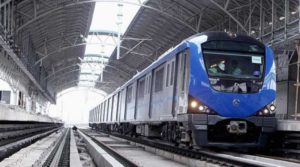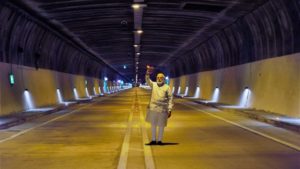
-Dr. Abdul Ruff
The much anticipated underground line of Chennai Metro Rail opened to the public on the 14th May, making the city the fourth in the country to launch such a facility after Kolkata, Delhi and Bengaluru. The line will cover a distance of eight kilometers from Nehru Park to Koyambedu, through tunnels and seven underground stations, to connect the already operational line at Koyambedu.
Tamil Nadu Chief Minister Edapaddi Palaniswami and Union Minister for Urban Development Venkaiah Naidu flagged off a train and inaugurated the 8km underground line between Thirumangalam and Nehru Park on Sunday the 14th May. The underground metro train line was a pet project of late CM J. Jayalalithaa.
The 7.4-kilometre stretch will connect Tirumangalam and Nehru Park along the inner periphery of North Chennai. Passenger services began 2 pm onwards. A few free services were run between Thirumangalam and Nehru Park. The underground line has seven stations, which are in turn linked to the elevated corridors through a ramp between Thirumangalam and Koyambedu.
The underground line gives several localities including Kilpauk, New Avadi Road, Shenoy Nagar and Anna Nagar access to mass transit facility for the first time. The train sped in its maximum speed non-stop across the seven underground stations till Nehru Park. It then took them on a ride on the ramp that connects the underground and elevated corridors to Koyambedu.
The trains will run along both tunnels only between Koyambedu and Shenoy Nagar. Only one tunnel will be operational for trains running up and down between Shenoy Nagar and Nehru Park, as it would not be possible for trains to change tracks without a crossover. There is a crossover at Shenoy Nagar, and another is being built at the Central metro station. Hence, the other tunnel between Shenoy Nagar and Nehru Park will be opened along with Central metro station, planned by the end of 2017.
The stations are also built underneath prime locations in the city, giving commuters easy access. Four entry/exit points built with elevators and escalators on either side of roads will make it hassle-free for passengers to get in and out of stations without having to cross the roads. The stations are also located close to stops for MTC buses which can ferry passengers to other parts of the city. However, they may not provide the last mile connectivity where commuters will be able to reach the interior areas of the neighborhoods around the stations in small buses or share autos.
While the underground stations are similar to the existing elevated stations regarding their two-level station design and ticket or token vending machines, passengers will still experience many new features. These may include air-conditioned interiors, tunnel ventilation systems, platform screen doors and detailed route maps to guide passengers to nearby localities.
Many commuters waited for several hours to take a free joy ride. The second train from Thirumangalam Station began its journey in the midst of applause and cheers from passengers. “We had been eagerly waiting for years for this line to open. It is worth the wait. The experience is something we have never had before,” said 61-year-old Arumugam, a resident of Thirumangalam who took a joyride along with his family.
Among the first passenger crowd were several residents from Thirumangalam and surrounding areas. A metro rail official confirmed they are all set to open the city’s first underground line on May 14. The inauguration comes almost a month after the commissioner of metro rail safety gave authorization for commercial operations after a three-day inspection across the stretch. Tamil Nadu minister for industries, steel control, mines & minerals and special initiatives M C Sampath visited the underground line between Thirumangalam and Nehru Park stations on Tuesday. The minister inspected the work in progress and safety measures, besides the facilities at the stations.
The inauguration of the first underground stretch of phase-1 of the project, which is jointly funded by the Centre and state, is expected to be attended by top officials from the ministry of urban development and the state transport department besides other senior officials from the state.
The stations will connect several neighborhoods including Kilpauk, New Avadi Road, Shenoy Nagar, Aminjikarai, Anna Nagar and Thirumangalam, giving access to mass transit facility for its residents for the first time. A part of the line will run about 18 meters under the arterial Poonamallee High Road.
With the underground line, commuters can head anywhere from Nehru Park to the airport in one direction, and to Little Mount in the other, in about 60 minutes with a single ticket. However, they may have to switch corridors at the Alandur Metro station, which is the elevated transit hub.
Metro rail’s first line was launched in June 2015 between Koyambedu and Alandur, covering a distance of 11 km through an elevated corridor. It was followed a nine-kilometer elevated line from Little Mount to the airport in September 2016.
Chennai Metro Rail has carried out a unique study that reportedly shows train vibrations do not affect the buildings close to the underground stretch. This is of significance in the backdrop of tunneling work leading to several road cave-in incidents across the city, and the first underground stretch is all set to open in a few days. According to officials of Chennai Metro Rail Limited (CMRL), the lining of tunnels is built in such a way that it can withstand a substantial amount of vibrations of trains. Also, a low vibration technology has been carried out before laying tracks at places where hospitals or laboratories are located, they said. Rubber pads placed. “We put rubber pads between stage one and stage two concrete of tunnel; after this process, the tracks are laid. The pads of 40 mm will dampen the vibrations from trains. These have been placed in 12 locations across the city, including Kilpauk Medical College, Rajiv Gandhi Government General Hospital and Vee Care Hospital. Hospitals have sensitive equipment which may feel even the slightest of vibrations and disrupt its functioning; hence this idea,” an official said.
In other areas too, though such pads are not laid, they claim the study and subsequent trials with trains show the vibrations are not beyond the permissible limit. Experts from IIT Madras said the precast segments that a tunnel is made of would take in the vibrations from trains.
B.N. Rao, another professor of civil engineering at IIT Madras, said, “I haven’t looked at the report, but they may have arrived at values and consequently gone ahead with operations based on different factors. This is because, usually, the vibration values will vary depending on the soil structure, the depth of tunnel and the speed of trains and its acceleration and deceleration in various areas.”
PM Modi inaugurated India’s longest tunnel in Jammu Kashmir

Indian railway has been making all out efforts to improve rail service to the people by constructing new long bridges and tunnels and dedicating them to the nation.
Chennai-Nashri tunnel, India’s longest highway tunnel, on the Jammu-Srinagar national highway, was inaugurated by Prime Minister Narendra Modi on April 02.
The prime minister was accompanied by road transport and highways and shipping minister Nitin Gadkari and minister of state for PMO and MP from Kathua-Udhampur constituency, Jitendra Singh.
Here are a few facts about the project: 1. The length of the tunnel is 9.28 km. The world’s longest highway tunnel is 24.51 km and is in Norway; 2. It will reduce the travel distance between Jammu and Srinagar by 30.11 km, which will help save fuel worth Rs 27 lakh daily; 3. Built on the lower Himalayan range at the height of 1,200 meters, it will cut travel time between the two cities by at least two hours; 4. The project cost is Rs 3,720 crore, Rs 1,200 crore more than the initial estimated cost;5. Work on the tunnel system started on May 23, 2011; 6. The main tunnel is 13 meter in diameter, the parallel escape tunnel is the 6-metre diameter and is connected by 29 cross passages at 300-metre gap; 7. The tunnel boasts of an integrated system that will control communication, ventilation, video surveillance, power supply, SOS call box, firefighting and incident detection and an FM signal repeater; 8. It is part of a 286-km-long four-lane project on the Jammu-Srinagar highway; 9. It is meant to avoid stretches of National Highway 44 prone to avalanches and landslides. Patnitop, Kud, and Batote will be bypassed now and 10. The speed limit in the tunnel will be 50km/hour, and headlights will have to be low beam
India’s longest river bridge.
Meanwhile, India’s longest river bridge, capable of withstanding the weight of a 60-tonne battle tank, will be inaugurated in Assam close to the border with China on May 26 by Prime Minister Narendra Modi. With the inauguration of the 9.15-km-long Dhola-Sadiya Bridge over the Brahmaputra River, Prime Minister Narendra Modi will start the celebrations of the NDA government’s three years in office from this eastern-most part of Assam. It is 3.55 km longer than the Bandra-Worli sea link in Mumbai, making it the longest bridge in India.
The bridge is seen as an attempt by India to shore up its defense requirements along the Sino-Indian border, particularly in the northeast, besides providing easy access to the people of Arunachal Pradesh and Assam with air and rail connectivity. “The prime minister will dedicate the strategically important bridge to the nation on May 26. It will bolster the road connectivity in the Northeast as the bridge will be used by people of Assam and Arunachal Pradesh besides defense forces extensively,” Assam Chief Minister Sarbananda Sonowal told PTI.
The construction of the bridge began in 2011 at a project cost of Rs. 950 crore. The design is such that the bridge can withstand the movement of military tanks. “Assam and Arunachal Pradesh have tremendous strategic value to the country. Since the bridge is located close to our border with China, it will help the swift movement of military troops and artillery in times of conflict,” Sonowal said.
The bridge is located 540-km away from Assam’s capital Dispur and 300 km away from Arunachal Pradesh’s capital Itanagar. The Aerial distance to the Chinese border is less than 100 km.
After Kaliabhomora bridge near Tezpur, there is no bridge over the Brahmaputra for the next 375 km upstream till Dhola, where the new bridge is constructed. Currently, all transportation between the river’s two banks is carried out through water only.
The bridge, when opened to the public, will cut down the travel time between Assam and Arunachal Pradesh by as much as four hours. As there is no civilian airport in Arunachal Pradesh, this bridge will help people of the state to reach the nearest rail head in Tinsukia and the airport in Dibrugarh quickly. Sonowal said the delayed works of the bridge was expedited after PM Modi assumed the charge in 2014. The bridge was originally scheduled to open in 2015.
The BJP government in Assam will complete one year in office on May 24. The bridge is one of the key projects of the Ministry of Road Transport and Highways in the Northeast and is built in public-private partnership with a construction company.
